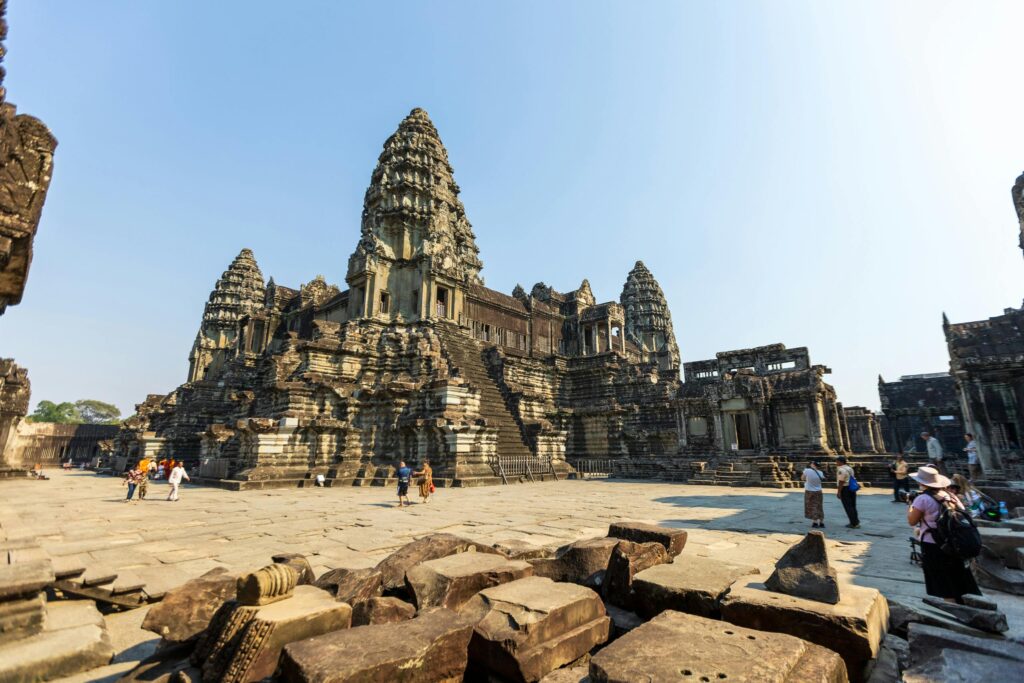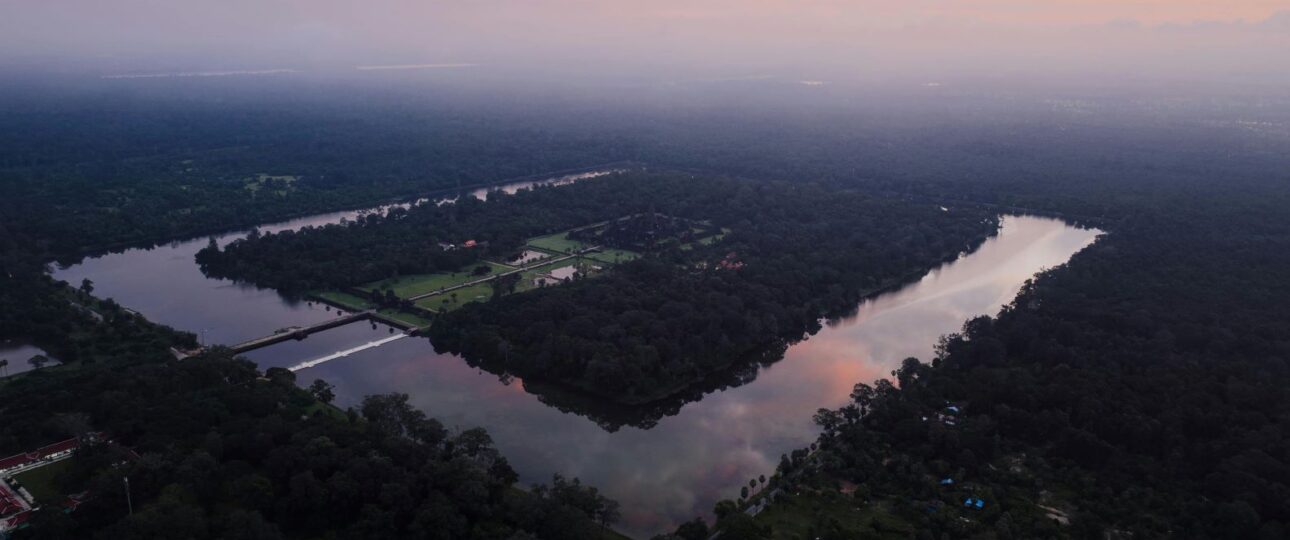📜Meaning and Origin of the Name “Angkor Wat”
- “Angkor” – Derived from the Sanskrit word Nagara (नगर), meaning “city” or “capital”.
- “Wat” – From the Khmer word voat (វត្ត), meaning “temple” or “monastery” in a Buddhist context.
🗣️ So, “Angkor Wat” translates roughly to “City of Temples” or more literally, “Temple City.”
Over 900 years ago, a mighty king named Suryavarman II dreamed of building a divine kingdom on Earth. From this dream rose Angkor Wat, a temple so massive and beautiful it was said to be made by gods. With its towering lotus spires and detailed carvings, it was created not just as a home for the Hindu god Vishnu, but as a symbol of heavenly perfection.
But time changes all. After the king’s death and centuries of change, the Khmer Empire faded. Yet while jungle swallowed many nearby temples, Angkor Wat never fell. It transformed peacefully—from a Hindu shrine into a Buddhist sanctuary—kept alive by monks who prayed in its halls.
Centuries later, explorers from Europe stood in awe at the jungle-hidden wonder. One Frenchman even wrote, “It is grander than anything left to us by Greece or Rome.”
Today, Angkor Wat is more than just ancient stones. It’s a living part of Cambodia—its pride, its past, and its soul. When you walk its halls, you walk with kings, gods, and centuries of devotion.

🏛️ 1. Origins and Construction (Early 12th Century)
Angkor Wat was built in the early 1100s by King Suryavarman II, ruler of the Khmer Empire, at the height of its power. The temple was originally dedicated to the Hindu god Vishnu, a rare choice since most Khmer temples were devoted to Shiva.
- Built between: ~1113–1150 AD
- Purpose: To serve as the king’s state temple and eventual mausoleum
- Architecture: Designed to represent Mount Meru, the sacred mountain in Hindu cosmology, surrounded by a moat symbolizing the cosmic ocean.
🔁 2. Transition from Hinduism to Buddhism (13th–16th Century)
After the decline of the Khmer Empire and the fall of Angkor Thom in the 15th century, Angkor Wat gradually shifted from Hindu worship to Theravāda Buddhism, which remains today.
- Buddhist monks continued to care for the temple even as other temples were abandoned.
- Statues and structures were adapted to reflect Buddhist beliefs.
- This peaceful transition helped preserve Angkor Wat while other temples fell into ruin.
⚔️ 3. Decline and Rediscovery (15th–19th Century)
Though never completely abandoned, Angkor Wat was largely isolated as the capital moved south. The temple remained in use by local monks but became less accessible.
- In 1586, Antonio da Madalena, a Portuguese monk, became one of the first Westerners to describe it.
- The temple remained relatively unknown to the wider world until Henri Mouhot, a French explorer, “rediscovered” it in 1860 and brought global attention to its grandeur.
🛠️ 4. Restoration and Global Recognition (20th Century to Present)
During French colonial rule, restoration of Angkor Wat began in the early 20th century. The temple suffered minor damage during regional conflicts, especially in the 1970s, but was largely protected.
- 1992: Declared a UNESCO World Heritage Site
- 2000s–Present: Continuous conservation efforts led by Cambodian authorities and international teams
- Tourism Boom: Angkor Wat is now the most visited tourist site in Cambodia and appears on the national flag — the only country to feature a temple on its flag.

🛕 Quick Facts about Angkor Wat:
- Built: Early 12th century (around 1113–1150 AD)
- Commissioned by: King Suryavarman II
- Original Purpose: A Hindu temple dedicated to Vishnu
- Later Use: Converted into a Buddhist temple (which it remains today)
- Style: Khmer classical architecture
- Significance: Largest religious monument in the world
✨ Why Angkor Wat is Special:
- Size & Scale: The complex stretches over 162 hectares – larger than the Vatican and the Taj Mahal combined.
- Architecture: Features intricate bas-reliefs, lotus-shaped towers, and perfectly symmetrical design.
- Symbolism: Represents Mount Meru, the mythical home of the gods in Hindu mythology.
- Sunrise View: Watching the sunrise over its main towers is a bucket-list experience for travelers.
🔍 What to See Inside:
- Bas-Reliefs: Over 800 meters of detailed carvings depicting epic stories from Hindu mythology like the Churning of the Ocean of Milk.
- Central Sanctuary: Once reserved for the king, now accessible to visitors (with proper attire).
- Reflecting Pools: Capture postcard-perfect photos, especially at sunrise.
📍 Location & Access:
- Nearest City: Siem Reap, Cambodia
- Distance: ~6 km (15–20 min by tuk-tuk or car)
- Ticket Required: Yes — part of the Angkor Pass (1-day, 3-day, or 7-day available)
💡 Travel Tips:
- Best Time to Visit: Early morning (sunrise) or late afternoon for soft lighting and cooler temperatures.
- What to Wear: Respectful clothing (shoulders and knees covered) as it’s still an active religious site.
- Guide Recommended: Absolutely — for deeper understanding of the temple’s history and symbolism.
